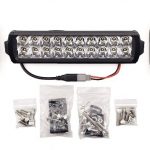In a previous article we discussed how to edge your flowerbed to give it a nice, clean appearance. There are a number of ways to edge your flowerbed beyond just cutting an edge.
For example, you can create a concrete edge. Such an edge does not have to be maintained and offers a decorative addition to your lawn and garden. Also known as a poured-in-place concrete border, the concrete edging can not only be used to edge a flowerbed, it can be used to surround a tree and can be designed and created to match landscape shapes. Moreover, it lasts for years.
Fiber-reinforced Crack Resistant Concrete is the ideal type to use in the construction of a flowerbed edge. You can even customize the concrete edging by adding a Liquid Cement color to the mix. Colors are available in red, brown, buff, charcoal, and terra cotta.
Tools And Materials
You will need an assortment of tools and material to construct the concrete edging.. They include:
• Saw
• Hammer
• Garden Hose or Rope
• ¼”x4”x8” plywood
• 1”x1”x12” Wood stakes
• 1” wood screws
• Drill with screw bit
• Wood Float
• Mixing Hoe
• Shovel
• Margin Trowel
• Edging Tool
• 1’x1’ Mixing Tub
• Concrete Edger
• Crack Resistant Concrete
• 10 oz. Liquid Cement Color
• Acrylic Concrete Cure and Seal
• Bucket
Step-By-Step Instructions
1. Lay out the border design shape using a garden hose or rope. The border width should be a minimum of 5-inches.

2. Use the shovel to cut the border layout to a width of 8-inches and a depth of 4-inches. Pack down the soil into a solid base.

3. Hammer the wood stakes into the ground at 18-inch intervals along the shape of the border.

4. Attach the plywood to the wood stakes using 1-inch wood screws.

5. Cut 1-inch x 1-inch boards in lengths equal to the width of the boarder to use as spacers. Place wood stakes along the outside shape of the border layout in 3-feet intervals. Place the spacers along the bottom edge of the plywood form to maintain a consistent width of the border.

6. Mix the concrete in the mixing tub to a firm workable consistency and pour into the border form. Use the margin trowel to spread and consolidate the mix.

7. After the bleed water disappears, smooth the surface with a wood float. Use the margin trowel to cut control joints a minimum of 1-inch deep into the concrete at 3-feet intervals. Consolidate and smooth the boarder edges using the concrete edger.

8. Apply the acrylic concrete cure and seal to the concrete and let it cure for three to five days and then remove the forms. Backfill against the lawn border with sod or dirt.
(Source: quikrete.com)







